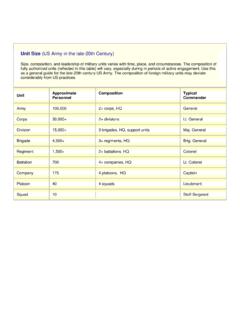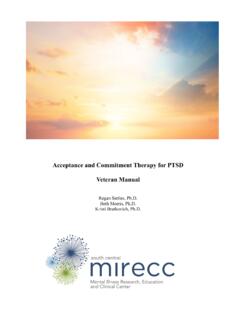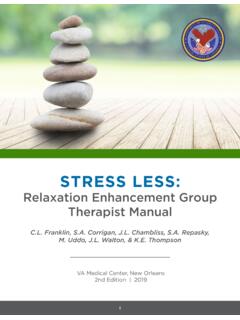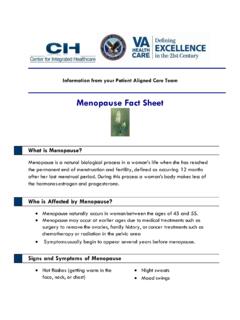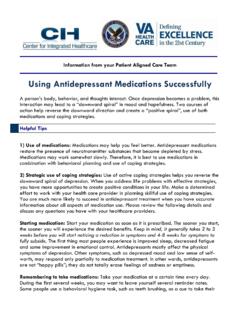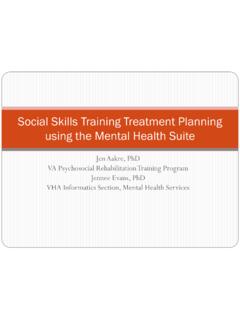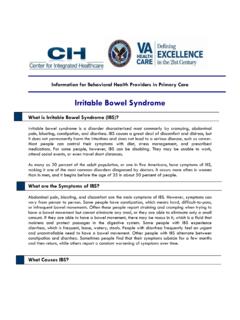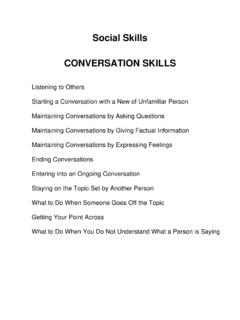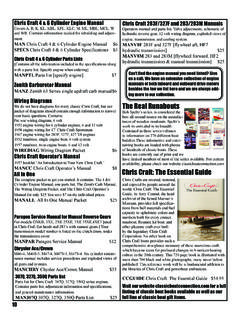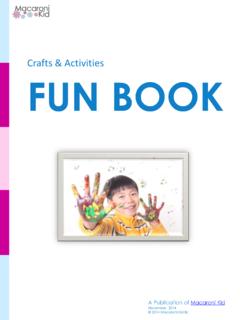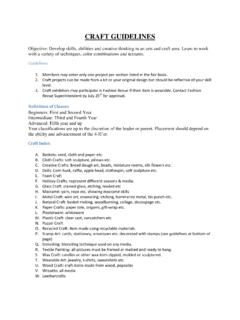Transcription of South Central (Rural) MIRECC Clinical Education Product
1 community REINFORCEMENTAND family training SUPPORT and PREVENTION (CRAFT-SP)Steven M. Scruggs, Robert Meyer, Rebecca Kayo, CRAFT-SP Table of Contents About the Authors .. v Acknowledgments .. vi Introduction .. 1 Handout Ia Building Group Rapport .. 12 Handout Ib Understanding Substance Dependence.. 13 SESSION OUTLINES Session One: Engaging CSOs into Treatment .. 15 Handout 1a CRAFT-SP Group Guidelines .. 20 Handout 1b Overview of CRAFT-SP training .. 21 Handout 1c Problems due to Alcohol and/or Drugs . 22 Session Two: Enhancing Motivation / Exploring Past Patterns. 23 Handout 2a Common Things CSOs / What I Can Get Out of CRAFT-SP training .. 28 Handout 2b Past Reactions to Drinking / Drug Use . 29 Session Three: Recognizing Signs of Intoxication / Contingency Management.. 30 Handout 3a Recognizing Triggers and Signs of Intoxication 35 Handout 3b How To Help a Loved One Stop.
2 36 ii Session Four: Selective Rewarding / Dealing with Intoxication 39 Handout 4a Rewarding Sobriety: When Your Loved One is Not Drinking . 46 Handout 4b Coping with Intoxication: When Your Loved One is Drinking / Using . 47 Session Five: Positive Communication.. 48 Handout 5a A Typical family Discussion .. 53 Handout 5b Positive Communication .. 54 Handout 5c Practice Role-Plays .. 57 Session Six: CSOs: Taking Care of Yourself.. 58 Handout 6a Developing a Support System .. 66 Handout 6b Barriers to Rewarding Yourself / Rewarding Yourself .. 67 Handout 6c Job Assistance: Helpful Resources .. 69 Handout 6d Recognizing Intimidation and Violence . 72 Handout 6e Quiz: How is Your Relationship? .. 73 Handout 6f Developing a Safety Plan .. 74 Session Seven: Allowing Negative Consequences / Anticipating Negative Repercussions.. 75 Handout 7a Negative Consequences / Anticipating Negative Repercussions.
3 81 Handout 7b When to Move Out / When to Reunite: Range of Options .. 82 Handout 7c Reuniting Plan .. 83 Handout 7d Certificate of Completion .. 84 iii Appendices Appendix A Review of Operant Behavioral Theory.. 85 Appendix B Contingency Management and Al-Anon Strategies: Detachment and Enabling .. 88 Appendix C Rapid Intake Procedures.. 91 References .. 93 Published by the Department of Veterans Affairs, South Central Mental Illness Research, Education , and Clinical Center ( MIRECC ), 2001. Last updated 12/15/2014. iv About the Authors Steven M. Scruggs, , received his doctoral degree at Biola University s Rosemead School of Psychology and completed a postdoctoral fellowship in Clinical child psychology at the University of Tennessee, Memphis. He is licensed as a Clinical Psychologist in Arizona, but currently practices in the Substance Abuse Treatment Center at the Veteran s Affairs Medical Center in Oklahoma City, OK.
4 He is a Clinical Assistant Professor at Oklahoma University Health Sciences Center. He worked as an Air Force Clinical Psychologist for several years before joining the VA staff. Robert J. Meyers, , is a research associate professor of psychology working at the University of New Mexico s Center on Alcoholism, Substance Abuse and Addictions, and is the Associate Director of the Life Link training Institute in Santa Fe, New Mexico. Dr. Meyers is the winner of the 2002 Dan Anderson research award from the Hazelden Foundation, and the 2003 young investigator award from the Research Society on Alcoholism. He has published over 50 scientific articles and co-authored 5 books on addiction, including Get Your Loved One Sober: Alternatives to Nagging, Pleading and Threatening and Motivating Substance Abusers to Enter Treatment: Working with family Members. Dr. Meyers has been in the addiction field for 30 years and at the University of New Mexico for over 19.
5 Rebecca Kayo , received her doctoral degree at the University of Kentucky, completed her internship at the Southwest Consortium in New Mexico, and her postdoctoral fellowship at the University of Oklahoma Health Sciences Center. She is currently licensed as a psychologist in Kansas and Oklahoma. She has worked in the field of dual diagnosis for over 10 years. v Acknowledgements Like many journeys, I didn t know how long this one would take when I got started. A simple suggestion to consider applying for a VA Clinical educator grant lead to a literature review and a four year project. As I arrive at the end of the road, there are many people to thank. Dr. Michelle Sherman gave me early encouragement and guidance on how to apply for a grant from the South Central (VISN 16) Mental Illness, Research, Education and Clinical Center ( MIRECC ). The review board provided the funds, without which nothing else would have been possible.
6 I was pleasantly surprised by the openness and enthusiasm of a nationally known researcher, Dr. Robert Bob Meyers, of the Center on Alcoholism, Substance Abuse, and Addictions (CASAA) of University of New Mexico, Albuquerque, to a new adaptation of his work with concerned significant others of substance abusers. Dr. Meyers, in turn, asked me to thank Drs. Jane Ellen Smith, William R. Miller and Brenda Wolfe, who all are contributors to prior CRAFT articles and books. Further, he would like to thank National Institute for Alcohol Abuse and Alcoholism and National Institute for Drug Abuse, for the funding of the original Clinical trials of CRAFT. My colleagues at the VA Medical Center in Oklahoma City have supported the project in many ways. Drs. Sean Ferrell and Catherine Shaw read an early draft of the CRAFT-SP manual and provided helpful feedback. Dr. Rebecca Kayo, as a postdoctoral fellow, provided enthusiasm and much needed input when the project lagged.
7 She co-facilitated the two pilots of CRAFT-SP. She helped edit the entire manual, but made significant contributions to the introduction and the chapter on communication. Dr. Michelle Sherman helped with the final edits and gave needed polish in tarnished areas. Similarly, Art Therapist Dawn Truby s graphic design work helped make CRAFT-SP worth looking at. Those who contribute the most to my life had no direct involvement in the CRAFT-SP project. However, I would be remiss if I did not acknowledge my wife Grace, and children, Ian, Sean, and Jon. They provide inspiration for me in more ways than I can count. Finally, I would like to acknowledge the Author and Perfecter of my faith, who gives a light to guide in darkness, and the desire to see people restored and families reconciled. Steve Scruggs, vi CRAFT-SP community reinforcement and family training Support and Prevention (CRAFT-SP) INTRODUCTION Substance use disorders are among the most prevalent and costly health issues facing our world today, posing serious health risks and severe consequences for people of all ages and backgrounds.
8 In 2003, an estimated million Americans ( ) suffered from substance abuse or dependence due to use of drugs, alcohol, or both (SAMHSA: Substance Abuse and Mental Health Services Administration, 2003). There were million Americans ( of the population) who used illicit drugs, 54 million who participated in binge drinking in the previous 30 days, and million ( ) who were heavy drinkers. From these individuals, million ( ) reported needing alcohol or drug treatment (SAMHSA, 2003). Despite the overwhelming number of individuals who have a substance use disorder, the number of people who actually receive treatment continues to be low. Every year approximately .5 million receive specialized substance abuse treatment for an illicit drug problem, million obtain treatment for alcohol problems, and million receive treatment for both alcohol and drug problems. Over 94% of people with substance use disorders that did not receive treatment believed that they did not need treatment (SAMHSA, 2003).
9 Large-scale surveys have shown that the vast majority of substance users do not seek help, with less than 10-20% of alcohol and other substance abusers actually entering treatment for this issue (Tucker & King, 1999). Providing more evidence for the difficulty engaging substance abusers in treatment, research by Fortney, Booth, Blow, Bunn and Cook (1995) shows that alcoholics are more likely to miss medical outpatient appointments than non-alcoholics. 1 Substance Use Rates Among Veterans More specific to the veteran population, national survey data indicate that substance abuse rates among male veterans are as high as that of male non-veterans (Office of Applied Studies, 2002, Office of Applied Studies, 2001a). In 2003, over 533,146 veterans in VA hospitals were diagnosed with a substance use disorder (PERC: Program Evaluation and Resource Center, 2002). Approximately 2 million or 6% of veterans report illicit drug use in the last year (Office of Applied Studies, 2002) and 7% report heavy drinking (Office of Applied Studies, 2001a).
10 Similar to non-veterans, veterans who have a substance use disorder often do not receive or seek substance abuse treatment. There is some evidence that veterans are more likely than non-veterans to be treated for alcohol abuse (Office of Applied Studies, 2001b). However, this does not mean that all those that need treatment are getting it. While the number of veterans diagnosed with a substance use disorder continues to increase the number of patients receiving substance abuse treatment continues to consistently decrease (PERC, 2002; Piette & Fong, 2001). Efficacy of Substance Abuse Treatment Research has consistently shown that patients in substance use treatment benefit from treatment ( , McCusker, Stoddard, Frost & Zorn, 1996). There is ample evidence that a range of chemical dependency treatments lead to significant reductions in use, improved physical and mental health, and increased social productivity ( , McClellan, Woody & Metzger, 1996).
